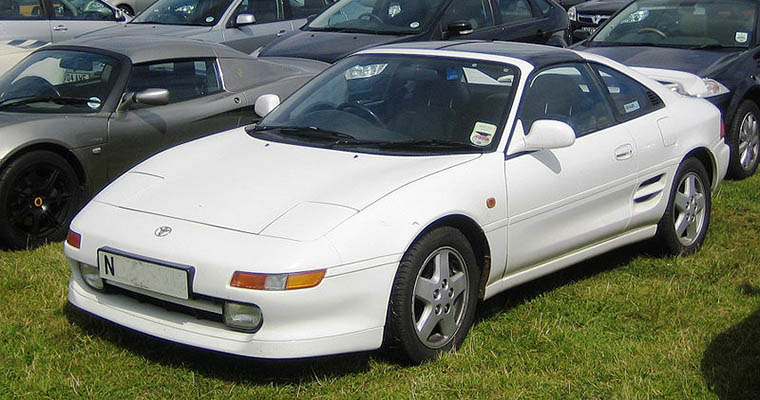

Toyota MR2 Second generation
The MR2 went through a complete redesign in 1989 (though North America did not receive them until late 1990 as 1991 models). The new car was larger and weighed 350 to 400 pounds (160 to 180 kg) more than its predecessor.
- Because of the resemblance to the Ferrari 348 and the Ferrari F355, the new MR2 was quite striking, and it is sometimes referred to as a "poor man's Ferrari."
- Japanese market trim levels:
- G with a NA 2.0L 3S-GE engine producing 165 PS (121 kW; 163 hp); with an A/T standard and an optional M/T. The G was the base model of the SW20 line-up. Standard features included: climate control, electric mirrors, and fabric door/seat trim.
- G-Limited with the NA 2.0L 3S-GE engine; an A/T was standard or a M/T was optional. The G-Limited was the higher-specification naturally aspirated SW20. Additional standard features: electric folding mirrors, steering fog lamps, and rear spoiler.
- GT-S with a turbocharged 2.0L 3S-GTE engine producing 221 PS (163 kW; 218 hp); a M/T was the only choice. The GT-S had the same standard features as the G-Limited.
- GT with the turbocharged 2.0L 3S-GTE engine and manual transmission. The GT was considered as the luxury specification in the SW20 line-up and had alcantera/leather door and seat trim in addition to G-Limited standard features.
- European market trim levels:
- Coupe with the NA 2.0L 3S-FE engine producing 138 hp (103 kW) (not available with T-bar roof).
- GT Coupe with the NA 2.0L 3S-GE engine producing 154 metric horsepower (113 kW; 152 hp).
- GT T-Bar with the NA 2.0L 3S-GE engine.
- There were no turbo models officially offered to the European market; however, many Japanese models were sold via the grey market.
- US market trim levels:
- MR2 with a NA 2.2L 5S-FE engine producing 130 hp (97 kW) and offered with a four-speed A/T or five-speed M/T.
- MR2 Turbo with a turbocharged 2.0L 3S-GTE engine producing 200 hp (149 kW), offered only with a 5-speed M/T (offered solely with the T-bar roof after early 1993).
There are many subtle visual differences between the normally aspirated and turbocharged models: including the "turbo" emblem (US) on the rear trunk, a fiberglass engine lid with raised vents, fog lights (though some Japanese and European NA models came with fog lights), and an added interior center storage compartment located between the two seats. All SW20 MR2s came with a staggered wheel setup, with wider wheels and tires in the rear than in the front.
- Mechanical differences on the Turbo models include, but are not limited to:
- 3S-GTE engine with associated air to air intercooler and different exhaust configuration;
- Stronger and heavier E153 gearbox with different ratios and stronger axles;
- Larger fuel pump and radiator.
- Models with 3S-GE and 3S-GTE engines had twin-piston front brake calipers. Models with the 5S-FE engine had only single-piston calipers.
The US market MR2 Turbo model was able to accelerate from 0-60 in 6.1 seconds and finish the 1/4 mile in 14.7 seconds.
Revisions and model year changes
The second-generation MR2 underwent a variety of changes during its 10 years of production, grouped in four different periods:
Jan-1992 (as the 1993 model year) to Oct-1993:
- Revised rear suspension with longer toe links
- 15-inch wheels and wider tires on all models
- Larger brakes (turbo only)
- Shorter shift lever and smaller knob
- Viscous LSD option (turbo only)
- Upgraded transmission synchronizers
- US turbo models now only sold with T-bar roof (except for a few sold in early 1993)
Nov-1993 and later (as 1994 & 1995 model year):
- European 3S-GE now rated at 180 PS (130 kW; 180 hp)
- American 5S-FE now rated at 135 hp (101 kW)
- Japanese 3S-GTE now rated at 245 PS (180 kW; 242 hp)
- Round tail lights
- Prior 3-piece rear wing replaced with revised one-piece
- Color-coded center panel, front lip and side skirts, one-piece spoiler
- Passenger airbag (not available for the Japanese market)
- American sales cease in 1995; turbo models are not offered in California-emission states after 1994
1996:
- Fender mounted turn signals on all models
- European 3S-GE down-rated to 170 PS (130 kW; 170 hp)
- Unavailable in North America
1998:
- Clear fender mounted turn signals
- New five-spoke 15-inch wheels
- Adjustable rear spoiler, revised from the earlier versions
- Red rings around gauges, red stitching on leather shift knob (and on leather seats on turbos)
- Japan receives the new BEAMS 3S-GE rated at 200 PS (150 kW; 200 hp)
Changes to the suspension geometry, tire sizes and power steering in Jan of 1992 (as the 93 model year) were made in response to journalist reports that the MR2 was prone to "snap-oversteer". As a counterpoint to the snap-oversteer phenomenon of the MR2, other journalists point out that most mid-engine and rear engine sports and super cars exhibit similar behaviour, and that a change to the driver's response to oversteer is really the solution. In any car, braking shifts the weight forward, and acceleration to the rear. When drivers enter a corner with too much speed, and lift the throttle mid-corner, the weight transfers forward causing the rear tires to lose traction (called lift-off oversteer), which can result in a spin. When improper steering inputs were made attempting to correct this non-power-on oversteer, the rear of the MR2 would swing one way, then wildly (and quickly) the other—thus the term "snap" oversteer. Toyota elected to change the MR2 suspension and tires to reduce the likelihood that this would occur, though many drivers would lament the change and claim that it "neutered" the sharp edge the MR2 was known for. Toyota claimed that the changes were made "for drivers whose reflexes were not those of Formula One drivers."
TRD2000GT
In 1998, Toyota Racing Development offered an official kit body conversion and tuning program for MR2 owners to transform their existing SW20 MR2 into a wide-body TRD2000GT replica car. This was to pay homage to the TRD2000GT wins in the GT-C Japanese racing series, since the TRD2000GT racing series cars were based on the SW20 floor pan. The TRD2000GT body kit widened the MR2 by a total of 100 mm (4 in). Prior to MR2s being fitted with the TRD2000GT body kit, TRD had its customers select which additional engine, suspension, wheel, and interior upgrades they wanted. For these reason, no two TRD2000GT MR2s are alike. It is rumored that at least one was built to produce up to 500bhp whereas some others had few modifications to their engines. Surprisingly, not all TRD2000GT MR2s were turbocharged. For example, TRD2000GT #001 came with a naturally aspirated 2.2L engine.
In order to ensure exclusivity, a high price tag was charged and total of just 35 factory car conversions were completed by Toyota Technocraft Ltd. Each official Technocraft-converted car was made using lightweight fiberglass components (front fenders, trunk lid extension, rear quarter panels, gas door, front and rear bumpers, 3-piece wing) and re-classified as completely new cars (with their own specially numbered TRD VIN plate riveted to the body to indicate their authenticity and rarity).
The Toyota Technocraft Ltd. TRD2000GT had a 60 mm (2.4 in) wider front and rear track (due to the addition of wider wheels and tires). Virtually every car converted also had other TRD parts fitted too, including extensive changes to both the suspension and engine. Most cars left the factory making more power due to TRD bolt-ons, some cars even left the factory boasting up to 500 metric horsepower (370 kW; 490 hp) and less than 1100 kg (2425 lb) for a very impressive power-to-weight ratio. While TRD Japan only offered a small number of kits with all body parts required for third-party conversion, Toyota Technocraft Ltd. offered complete car conversions.
Apart from the cars listed on the TRD2000GT register it is unknown how many original Toyota Technocraft Ltd. cars still exist today, but it is rumored that approximately 10 conversion kits were imported from TRD Japan into the US for conversions. In many respects, the extended body can be compared to that of a Porsche Turbo wide body. The car's width is extended and body dimensions dramatically changing the car's overall visuals. Very little is known about these cars outside of Japan.
SW20 Spider
Between 1996 and 1999, Toyota TechnoCraft (TTC) produced 91 MKII SW20 MR2 Spiders. These cars featured a retractable, cloth softtop roof, wingless trunk lid, and an engine lid that was unique to the SW20 spider. Most of these cars were automatics and nearly all of them sported a naturally aspirated engine. Interestingly, Toyota decided against putting its name or logo on these cars as a result of its desire to distance itself from cars that featured leaky roofs. Most of the Spiders came in Lucerne Silver with a blue side moulding and featured black and blue accented cloth seats.
Motorsport
Le Mans: SARD MC8-R
The Sard MC8-R was a modified and lengthened version of the SW20 built for GT racing by Toyota's works team SARD (Sigma Advanced Research Development). The MC8-R housed a twin-turbo version of the 4.0-liter Toyota 1UZ-FE V8 producing 600 bhp (450 kW). Eligible for the GT1 category, the MC8-R lacked pace against the new generation sports cars and homologation specials such as Porsche 911 GT1, but did compete alongside a similarly modified Toyota Supra. One MC8 road car was built in order to meet homologation requirements, but its current whereabouts are unknown.
1995 and 1996
- The MC8-R made its first outing in the 1995 24 Hours of Le Mans piloted by Alain Ferté, Kenny Acheson, and Tomiko Yoshikawa. It retired after 14 laps. Later that year the car attempted the 1000km Suzuka, this time managing to finish 26th overall.
- One MC8-R was entered in the 1996 24 Hours of Le Mans, piloted by Masanori Sekiya, Hidetoshi Mitsusada, and Masami Kageyama. The team qualified 37th and finished 24th, second-to-last of finishers.
1997
The team also entered the 1997 24 Hours of Le Mans, but driver Olivier Grouillard failed to make it past pre-qualifying.[24] Two cars were also entered in the FIA GT Championship round at the 1997 Suzuka 1000km (one by Team Menicon SARD and one entered by IDC Ootsukakagu SARD), but neither car managed to finish. It was replaced for the following year with the Toyota GT-One.
Japanese Grand Touring Championship (now Super GT)
1998
Team Taisan Jr. with Tsuchiya campaigned a Toyota MR2 powered by the factory 3S-GTE powerplant in the 1998 JGTC season. Keiichi Tsuchiya and Shingo Tachi drove five class victories in seven races, winning the teams' championship and tying for the drivers' championship.
1999
For following year, Team Taisan Jr. moved to a Porsche chassis in GT300, while Momocorse Racing Team with Tsuchiya campaigned another Toyota MR2 and won both championships. Morio Nitta and Shin'ichi Takagi drove to one victory, two 2nd places, and one third place to secure the teams' championship, with Nitta winning the drivers' championship by just one point over the Nismo Silvia that was driven by Takeshi Tsuchiya and Yuji Ide. Momocorse Racing would move to the MR-S chassis for the 2000 season, marking the end of the SW20's participation in JGTC.







